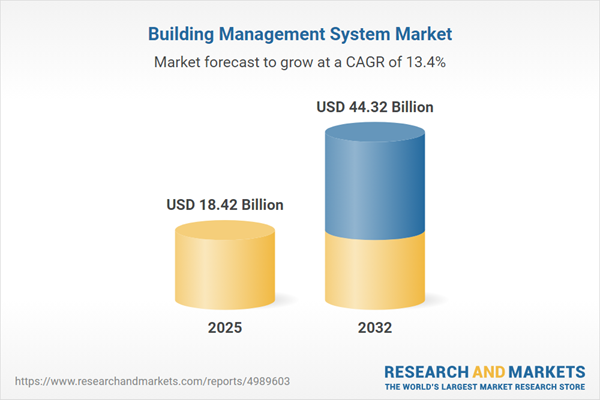Speak directly to the analyst to clarify any post sales queries you may have.
The building management system market is transforming how organizations oversee and optimize facility operations. Senior decision-makers now rely on integrated, automated platforms to address sustainability, efficiency, and evolving compliance needs in complex environments.
Market Snapshot: Building Management System Market Size, Growth, and Trends
In 2024, the global building management system market reached USD 16.23 billion, with projections moving to USD 18.42 billion by 2025. Looking ahead, a compound annual growth rate (CAGR) of 13.38% forecasts expansion to USD 44.32 billion by 2032. This growth reflects the move from traditional system controls to smart, automated solutions. Executive focus has shifted toward improving operational transparency, deploying advanced analytics, and enabling both remote and real-time management across portfolios. Current market trends emphasize predictive maintenance tools, greater energy optimization, and tighter alignment between building management practices and overall property strategies, reflecting industry-wide priorities for operational efficiency and risk management.
Scope & Segmentation of the Building Management System Market
- Component Types: Actuators, controllers, sensors, analytics software, and value-added services form critical layers. These enable facilities teams to achieve precision control, broader oversight, and agile responses in commercial and industrial sites.
- Applications: Demand response, load and energy management, HVAC and lighting controls, real-time analytics, facility monitoring, and integrated building security all address the operational demands of regulated and high-stakes environments.
- End Users: Offices, retail properties, defense installations, education campuses, manufacturing centers, logistics hubs, healthcare sites, warehouses, and residential complexes. These segments vary by workflow challenges, compliance demands, and required pace of technology adoption, influencing integration strategies.
- Regions Covered: North America, Latin America, Europe, Middle East, Africa, and Asia-Pacific. Adoption and technology deployment differ according to regional infrastructure maturity and policy contexts, shaping investment priorities and market momentum.
- Key Companies Profiled: Johnson Controls International plc, Schneider Electric SE, Siemens AG, Honeywell International Inc., Carrier Global Corporation, ABB Ltd, Emerson Electric Co., Legrand SA, Cisco Systems Inc., Eaton Corporation plc. These leading companies set the pace for innovation and offer global expertise in the sector.
As organizations consider adoption, they emphasize automation quality, the depth of actionable insights, and seamless system integration across both current and future real estate portfolios. Flexible and scalable solutions are essential for handling regulatory evolution and supporting strategic growth.
Key Takeaways for Senior Decision Makers
- Integrated building management platforms enhance overall portfolio oversight and simplify sustainability reporting for multi-asset organizations.
- Leveraging cloud-based and AI-driven technologies accelerates maintenance processes and minimizes operational disruptions.
- Modular, interoperable system structures enable long-term adaptability in response to changing regulatory, infrastructure, or business requirements.
- Deploying targeted management solutions supports compliance in sectors with stringent operational demands or safety standards.
- Accounting for regional infrastructure and policy variation enables effective customization and risk mitigation during technology rollouts.
- Active partnerships with suppliers ensure ongoing compliance, facilitate timely technology upgrades, and simplify navigation of updated standards.
Tariff Impact: Sourcing and Resilience Planning
Changes in US tariff policy are prompting firms to revisit their sourcing strategies and supply chain management for building management systems. Senior leaders respond by diversifying supplier relationships and selecting modular, adaptable technologies to reduce operational exposure. Priorities now extend to ensuring transparency in procurement, strengthening digital security, and developing resilience measures optimized for dynamic market logistics. These steps maintain operational integrity while supporting new regulatory and supply chain expectations.
Methodology & Data Sources
This report draws from structured interviews with senior executives, direct interactions with leading technology vendors, comparative product studies, and in-depth case analyses. Robust supply chain reviews inform recommendations that align with both tactical needs and long-term strategic objectives of facility management stakeholders.
Why This Report Matters
- Empowers leadership to identify precise investment opportunities in building management system solutions and proactively shape strategy amid regulatory shifts.
- Delivers actionable segmentation and market analysis to enhance compliance programs, streamline efficiency, and match sector-specific or regional objectives.
- Advises on building ESG and digital risk management strategies, positioning organizations to strengthen asset value in complex facility networks.
Conclusion
Building management system platforms provide the digital backbone for efficient operation, ongoing compliance, and durable facility performance. Strategic adoption today ensures greater resilience and flexibility in an evolving property landscape.
Additional Product Information:
- Purchase of this report includes 1 year online access with quarterly updates.
- This report can be updated on request. Please contact our Customer Experience team using the Ask a Question widget on our website.
Table of Contents
3. Executive Summary
4. Market Overview
7. Cumulative Impact of Artificial Intelligence 2025
Companies Mentioned
The companies profiled in this Building Management System market report include:- Johnson Controls International plc
- Schneider Electric SE
- Siemens Aktiengesellschaft
- Honeywell International Inc.
- Carrier Global Corporation
- ABB Ltd
- Emerson Electric Co.
- Legrand SA
- Cisco Systems Inc.
- Eaton Corporation plc
Table Information
| Report Attribute | Details |
|---|---|
| No. of Pages | 195 |
| Published | October 2025 |
| Forecast Period | 2025 - 2032 |
| Estimated Market Value ( USD | $ 18.42 Billion |
| Forecasted Market Value ( USD | $ 44.32 Billion |
| Compound Annual Growth Rate | 13.3% |
| Regions Covered | Global |
| No. of Companies Mentioned | 11 |









